
ICCROM_ICS11_History_en
.pdf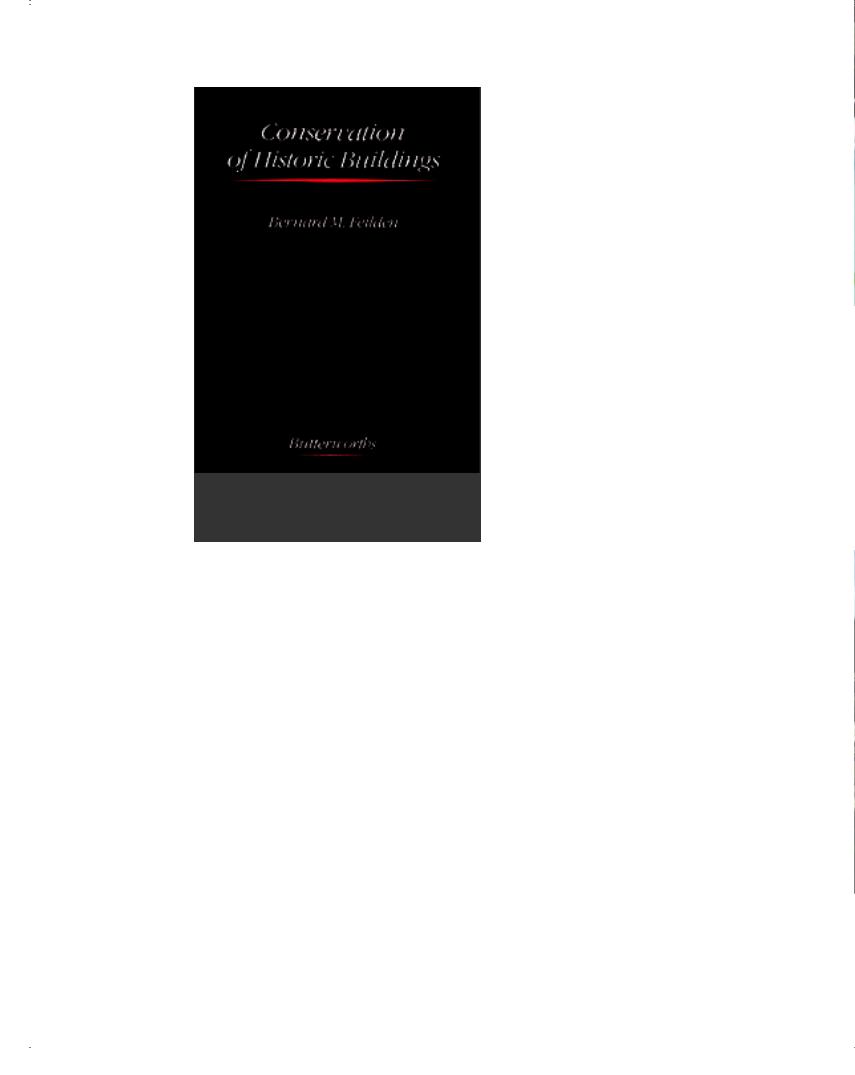
Figure 5 10
Butterworths publications produced in collaboration with ICCROM
other. It based its programmes on close links and co-operation with major conservation laboratories and research institutions in the different Member States. Keeping abreast with the most advanced conservation theory and scientific knowledge, ICCROM was able to develop training programmes as a direct response to the modern conservation approach. Indeed, the international training courses, as they were developed in the 1970s, became the principal instruments for diffusing the modern conservation approach, counting also on the idea of forming ‘ambassadors’, who in turn could diffuse the message (the ‘snow-ball effect’, as Philippot used to call it).
In 1980 ICCROM signed a contract with the publishing house Butterworths to collaborate in the publishing a new Series in Conservation and Museology. Under the agreement, ICCROM paid a subvention to assist authors, to improve the quality of production and to lower the retail price, while retaining translation rights. The first book in the Museum Environment Series was a reprint of The Museum Environment by Garry Thomson. Publications in the Conservation Series came to include the
Conservation of Historic Buildings by Feilden, the
Conservation of Wall Paintings by Philippot and the Moras, and A History of Architectural Conservation by Jokilehto. The latter text had its origins in 1978 in part-time doctoral research that the author carried out at the University of York on the history and philosophy of architectural conservation on the recommendation of Feilden and Linstrum. All these publications have been subsequently translated into several languages, serving as fundamental texts for improving teaching in this field.
Feilden contributed to the development of ICCROM training strategies by emphasising the interdisciplinary character of conservation, and the need to introduce laboratory personnel to the field and field persons to the laboratory. An important tool was the preparation of Visual Inspection Reports by participants of the different courses, whether conservators, architects or engineers, or indeed museum personnel. At the 12th General Conference of ICOM in Mexico City (October-November 1980), Feilden presented a paper on Regular Inspection and Storage of Museum Collections, proposing that inspection practice be introduced as a regular tool for the management of museum collections. In 1980, he wrote an Editorial for the ICCROM Newsletter 6, asking:
“Do we value our cultural heritage? Do we want to preserve it? ... Assuming that those in charge have proper cultural and technical preparation, the methodology of conservation depends essentially upon regular inspections, formal reports and prompt preventive action. Reports should define the object as a whole in its context, describe its history and the materials it is made of, record how it has been used and abused, together with the state of its present condition. If any defects need keeping under observation, they should be noted and specially reported upon in the next regular inspection, which should be at a defined interval of, say, six months for books in a library or archive, one year for framed canvas paintings and textiles and every five years for historic buildings.”170
Once the regular inspections are established, he argued, one should always give estimates of the cost of intervention, and indicate the urgency of the work under four main categories: immediate, urgent, necessary, and desirable.
The aim of the ICCROM laboratory was to support documentation, promotion of research, and to offer advice and recommendations, especially related to training and emergency services. In 1981, ICCROM prepared for the Council a document on Guidelines for a National Policy for Conserva-
70 |
ICCROM and the Conservation of Cultural Heritage. A history of the Organization’s first 50 years, 1959-2009 |
|
|
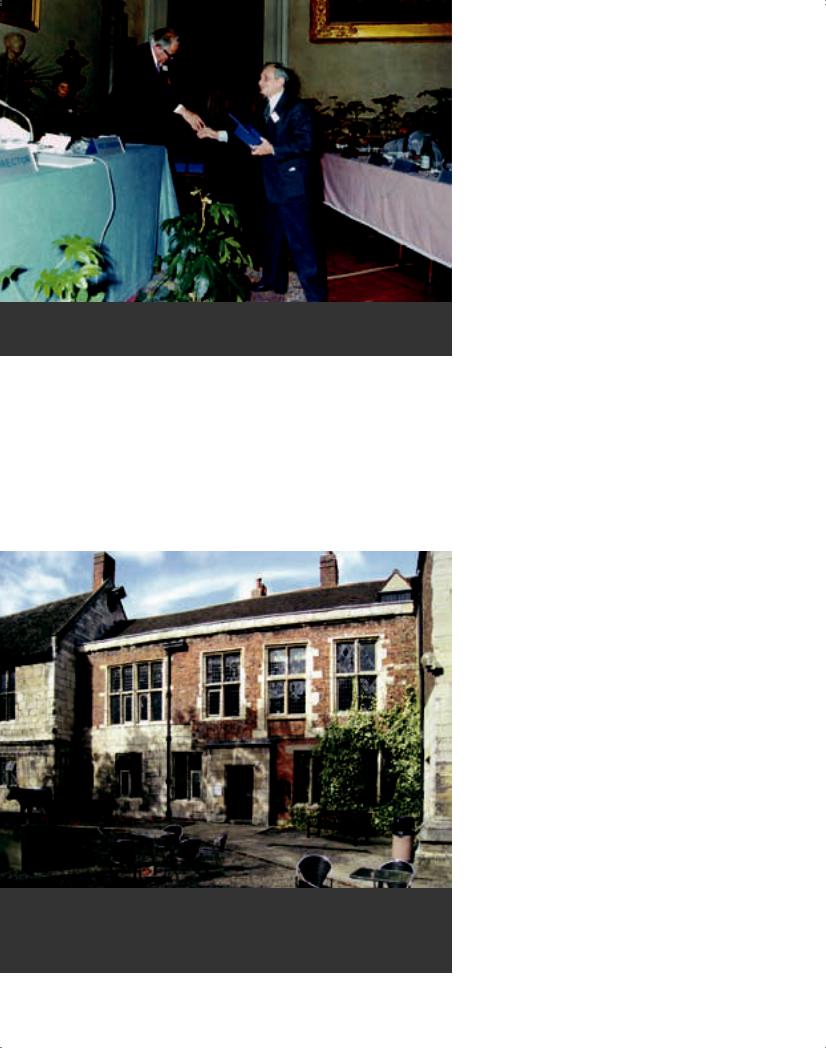
Figure 5 11
Maurice Chéhab receiving the ICCROM Award
tion Laboratories.171 This document outlined the types of laboratories that could be useful for conservation purposes, defining the field of application of the laboratory, the required staff, premises and equipment. The ICCROM Laboratory proved extremely useful for the purposes of training and small-scale research. Since ICCROM had a statutory relationship with institutions equipped with sophisticated facilities, it was easy when required to establish joint projects on more complex issues.
Figure 5 12
Inner courtyard of the historic King’s Manor in York, home of the Institute of Advanced Architectural Studies (IoAAS) of the University of York, with which ICCROM signed an MoU for exchanges in conservation training
In 1978 Feilden raised with the Council the question of recognition of ICCROM’s international courses. Should these courses offer a diploma and, if so, what level of diploma should it be? Past participants had complained that the ICCROM certificate was not properly recognized in their countries. Feilden’s idea was that the proposed ICCROM diploma should be aimed at a higher standard than other courses and could, for example, serve as a guarantee for UNESCO when searching for suitable professionals. Council members, after a long debate, decided not to adopt this idea. Maurice Chéhab (Lebanon) observed:
“Mr President, listening to the various statements we arrive at these results. Various persons have stressed the fact that the constitution of ICCROM has always avoided that we should become a superior Centre, or else a super laboratory, and the creation of the school is partly the creation of a super University degree. Evidently, this is very difficult, but, on the other hand, actually, if we have to address one of our sons to a career, we seek information on which is the best school in the world, not necessarily on our own country, but we look for where we can send him, in our own country and elsewhere. But how come this University is so well known? Because, in practice, people have come to know that whoever comes from it is better prepared than those who come from other Universities.”172
Chéhab proposed that ICCROM should continue giving a certificate and not a diploma. The certificate could indicate what the holder had studied and how long, and with time someone with this type of training would be recognized as a capable professional. Vassos Karageorghis (Cyprus) proposed that, instead of a diploma, ICCROM should establish a title such as “Fellow of ICCROM”, which would be a sort of “super qualification which would satisfy the super-conservator.”173 Philippot suggested, without objecting to Feilden’s proposal, that it was a question of establishing priorities and to concentrate the efforts first of all “on the way of ensuring a strict method, a strict curriculum where this does not exist.”174 The conclusion was to create a Training and Standards Committee which would discuss these questions further. In practice, participants of the ARC course could continue their studies either at the University of Rome or at the University of York, both of which recognized ICCROM’s training. In Rome they could undertake the examinations and prepare a thesis for a diploma, and at the University of York could prepare a dissertation for Master’s degree.
5 ICCROM comes of age (1977-1988) |
71 |
|
|
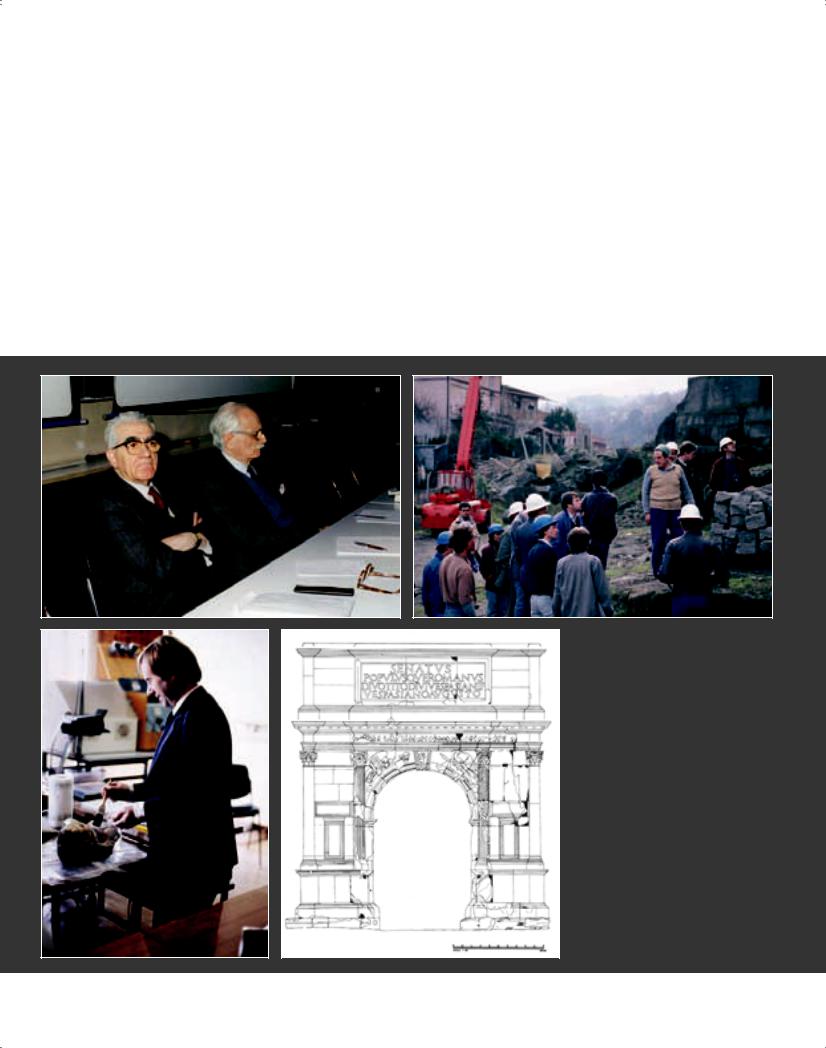
Regular ICCROM courses
From 1977 the architectural conservation courses had been divided into two. The University Course
(A) of the Scuola di Specializzazione per lo Studio ed il Restauro dei Monumenti was attended by students under Italian rules of entry. After the retirement of De Angelis, Renato Bonelli and then Gaetano MiarelliMariani directed it as an independent university course leading to a diploma of specialization. In 1979, it had 163 participants who were mainly Italian. The ICCROM Course (B) was reserved for international participants who met ICCROM admission requirements, numbering usually around 25 a year, and was taught in English. The more manageable number of participants in this course made it possible to organize
a small testing laboratory to introduce participants to the use of scientific methods and instruments. Participants tested samples taken from buildings that were studied as part of the course work (planning and coordination by Simonetta Peroni in collaboration with Giorgio Torraca and John Ashurst). The exercises were further developed and later published for wider diffusion by Jeanne-Marie Teutonico.175 The fieldwork included a preliminary study of a section of the historic town of Rome (Tor di Nona area), which also served to test the applicability of computers in the management of information. Under the coordination of Sergio Lucarelli, the Photogrammetry Section of ICCROM carried out a series of field projects with selected course participants who
Figure 5 13 (above left)
Renato Bonelli and Guglielmo De Angelis d’Ossat in a training session at ICCROM (photo Calogero Bellanca)
Figure 5 14
John Ashurst was one of the principal lecturers on materials in the ARC course
Figure 5 15
ARC course visiting a stone quarry, guided by John Ashurst
Figure 5 16 (below right)
Photogrammetric recording of the Arch of Titus, a project conceived by Sergio Lucarelli (ICCROM) and Hans Foramitti (Bundesdenkmalamt of Vienna) in 1973
72 |
ICCROM and the Conservation of Cultural Heritage. A history of the Organization’s first 50 years, 1959-2009 |
|
|
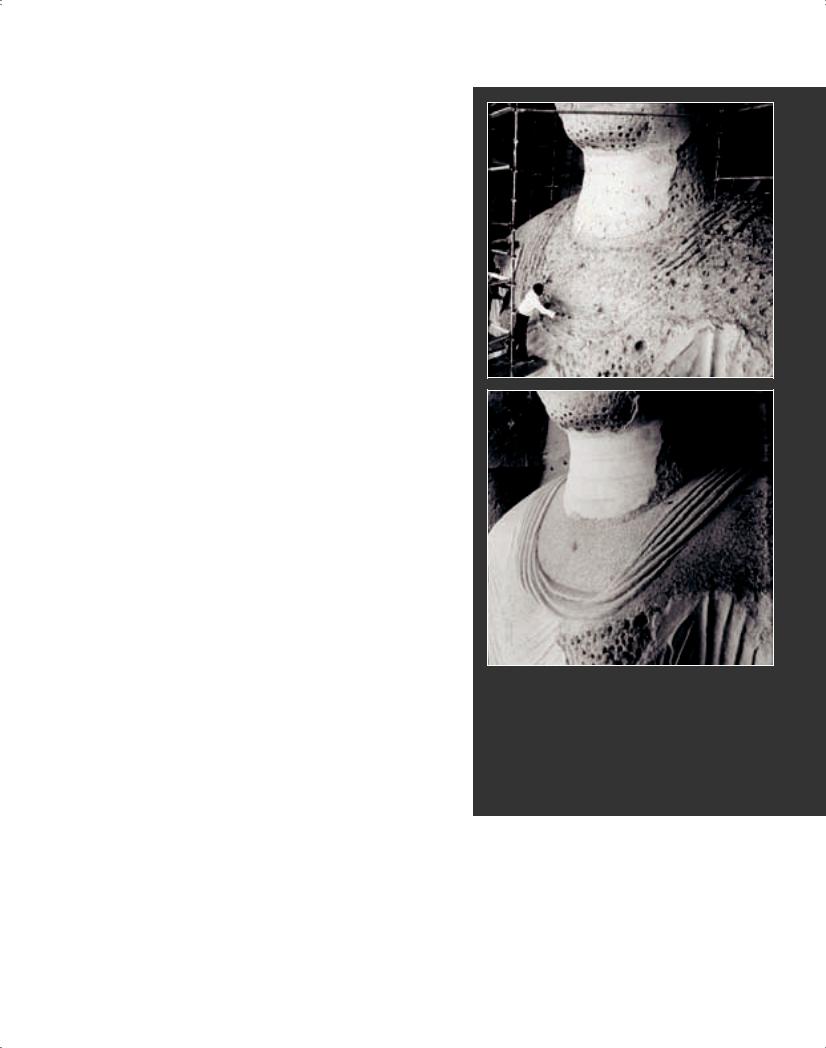
prepared recordings of historic buildings and sites in Rome and in Friuli (after the earthquake there).
Rakhaldas Sengupta, member of ICCROM Council and Director (Conservation) of the Archaeological Survey of India, referred to the many challenges faced particularly on archaeological sites, and stressed that ICCROM could play the role of a catalyst. “It has been effectively spreading the philosophy of conservation, providing technical assistance to those in need, initiating research works in important and vital subjects and spheres and conducting training courses to disseminate knowledge to groom new generations of guardians of cultural heritage.”176 He noted that an associate professor (Nalini Thakur, ARC82) of the Delhi School of Architecture who had been trained at ICCROM was involved in creating a regional training centre in New Delhi. He also proposed collaboration between the School of Architecture and the Archaeological Survey of India in training at both under-graduate and post-graduate levels.
José Maria Magaña, a former participant of ARC76, joined the ICCROM team assisting the Italian authorities after the 1976 earthquake in Friuli. After his return to Guatemala, he was appointed Conservator of the City of Antigua Guatemala, allowing him to put into practice the lessons learnt at ICCROM. “It was at the time I assumed the technical and administrative direction of CHPAG that I realized the importance and applicability of my training. I succeeded in bringing together a group of competent professionals concerned with the protection, conservation and restoration of Antigua to head each of the ... departments.”177
In June-July 1979 ICCROM organized a Conservation Workshop Tour for former participants, with the financial support of UNESCO and the German Democratic Republic, and in collaboration with several national institutions in Austria, Czechoslovakia, GDR, Germany, France and Switzerland. The previous year it had run in Rome a short course in architectural conservation for French-speaking African countries, a short seminar-type training programme consisting of lectures, discussions, visits and contributions by participants with the aim of improving the attitudes of conservation professionals. Other short courses in Rome were organized for the University of Washington in Seattle, USA, and the University of Gothenburg.
In 1977 and 1978 the Mural Paintings Conservation Course (MPC) moved to new premises in the lower wing of San Michele. There, under the coordination of Paul Schwartzbaum, it prepared a permanent exhibition of the various types and techniques of plaster preparation for mural paintings. The programme of the course was revised, expanding
Figure 5 17
Giant Buddha statue in Bamiyan (Afghanistan): joint restoration project carried out from 1969 to 1973 by the Archaeological Survey of India and Afghan authorities (photo R. Sengupta)
Figure 5 18
Giant Buddha statue in Bamiyan (Afghanistan): completed restoration (photo R. Sengupta)
the theoretical part and increasing study visits to case histories in and around Rome. In 1977 the course participants worked in the Castello Caetani at Sermoneta, as in previous years, and in Roman churches such as Santa Maria dell’Orto and San Benedetto in Piscinula, where they revealed an entire pictorial surface of important 12th-century frescoes. In 1979, in agreement with the Italian authorities, the
5 ICCROM comes of age (1977-1988) |
73 |
|
|
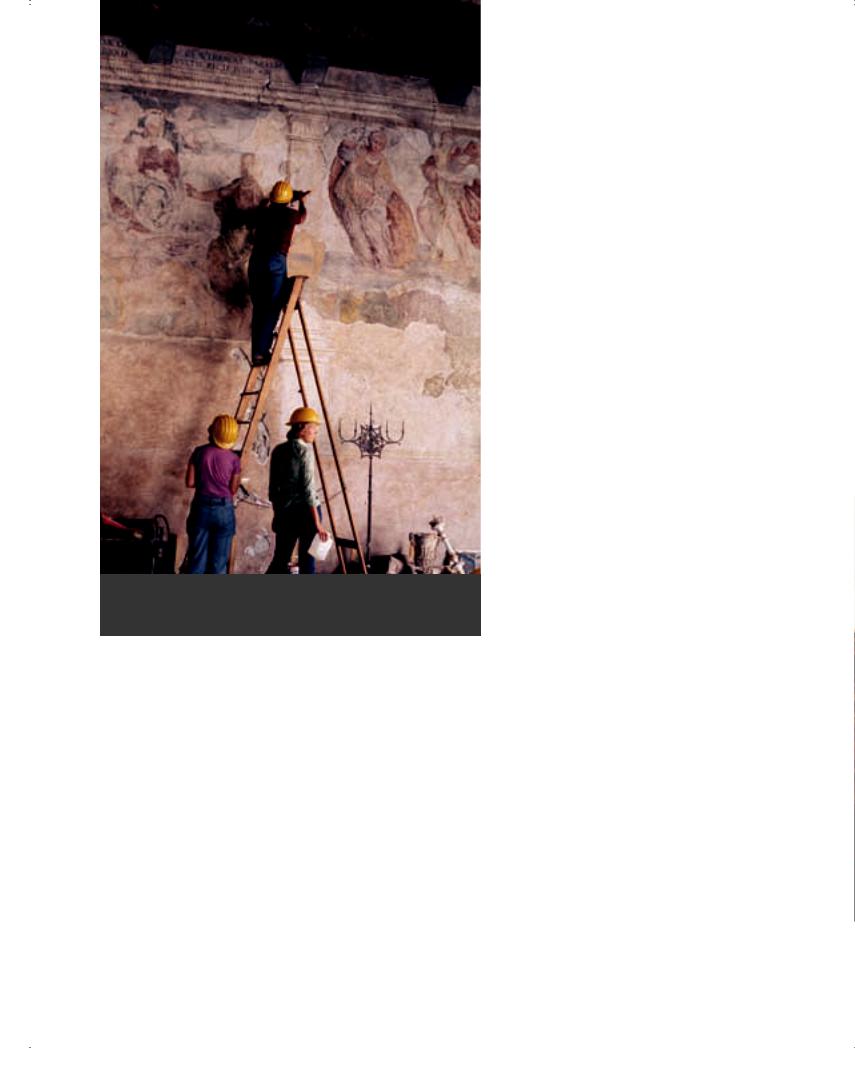
Figure 5 19
Mural paintings course in Venzone (Friuli), restoring the wall paintings of the Town Hall, 1976
course participants helped plan major conservation work at the Crypt of San Crisogono, an important Early-Christian Basilica with frescoes from the 4th, 8th and 11th centuries.
The course on Fundamental Principles of Conservation was renamed, first, Course on Conservation Science, and then the Scientific Principles of Conservation Course (SPC). It developed further under the co-ordination of Lena Wikström (Finland), expanding particularly the sections on textiles and stone, and introducing new sections on ceramics, plastics, polychrome sculpture, engravings and watercolours. Both the SPC and Mural Paintings courses were bilingual (English-French) with consecutive interpretation, so as to widen their participation. The two-month UNESCO Stone Conservation Course, held in English, continued in Venice in collaboration with the Italian authorities and co-ordinated by Lorenzo Lazzarini.
The short course on Security, Climate Control and Lighting in Museums, co-ordinated by de Guichen in Rome, was renamed Course on Preventive Conservation in Museums, following a decision of the Council. The course lasted two weeks before being extended to two-and-a-half weeks, and was held in English and French in alternate years. In November 1978, ICCROM organized an international conference on Climate Control in Museums with financial assistance from the Direction of French Museums and UNESCO. The conference issued a recommendation with messages on climate control to different stakeholders, including government officials and the public, administrators, directors of museums and general secretariat, architects and designers, curators, and conservator/restorers and museum scientists. The message to curators (rapporteur Garry Thomson) noted that all objects whatever their age, origin or material react to the surrounding atmosphere, which causes irreversible deterioration. The function of the curator is to preserve this heritage for future generations. In this task, “the object comes first.”178
Robert Organ, Chief of the Conservation Analytical Laboratory at the Smithsonian Institution, presented a paper on “The lessons of nature” at the International Conference on Museum Storage in Washington in 1976, and published it in ICCROM’s Newsletter 6. Here he noted that objects are not eternal, but one can prolong their life with proper activities. “If flies can leave deposits on objects, they will. If dust can fall on objects, it will. So, protect them. If the relative humidity can fall and cause something to crack as a result of humidity change, it will. So, protect against it by the use of moisture blast. Protection cannot be left entirely to machines. Perhaps the most important lesson from nature is that among inanimate things confusion increases - machines break, objects fall and shatter, water corrupts and destroys. The ultimate in safety for collections can only be obtained through the perpetual and far-seeing vigilance of many humans operating at their highest levels of interest in the objects placed in their care and for their study.”179 In this respect Organ and Feilden strike the same note in stressing the importance of human intervention over reliance on automated systems and machines.
In November 1977, ICCROM held a conference on the conservation of mosaics with the financial support of UNESCO, the Direction of French Museums and the Goethe Institute. Some 50 specialists attended this three-day meeting which led to the establishment of an International Committee for Mosaic Conservation, for which ICCROM acted as Secretariat for the first years. It published the acts of the Conference as Mosaic 1180 and those
74 |
ICCROM and the Conservation of Cultural Heritage. A history of the Organization’s first 50 years, 1959-2009 |
|
|
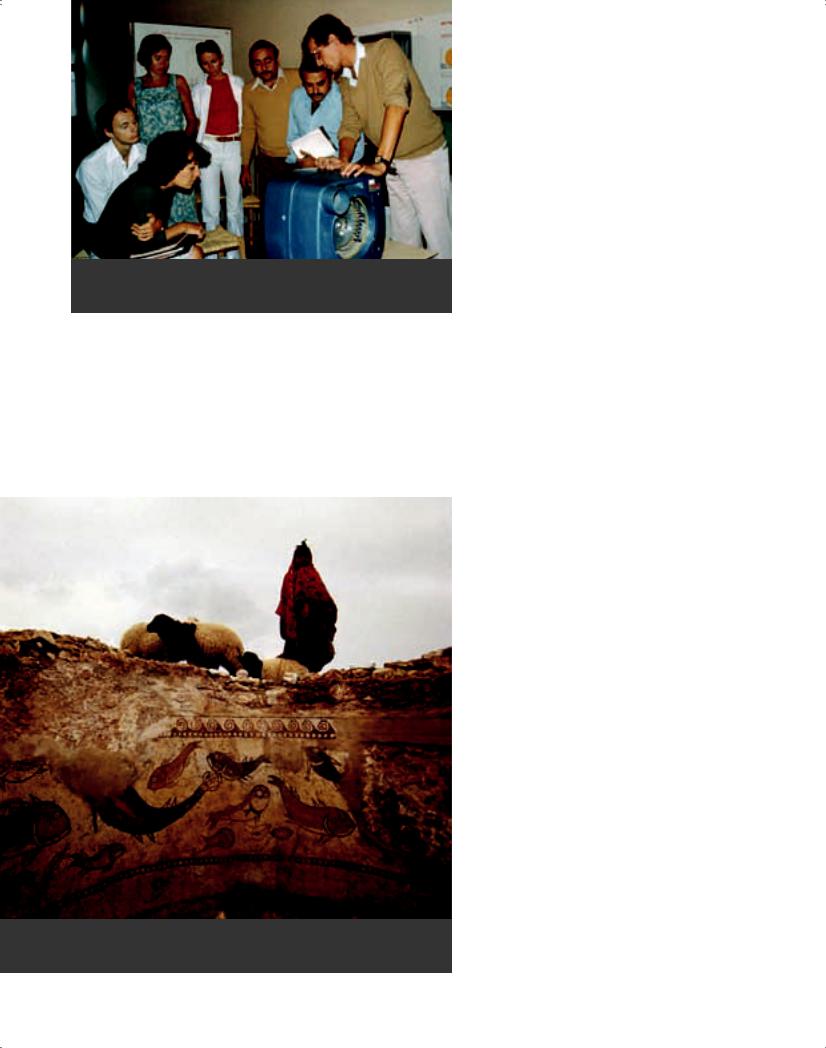
Figure 5 20
Gaël de Guichen teaching a course on Preventive Conservation in Museums
of the second meeting of the Mosaic Committee (ICCM) as Mosaic 2.181 In 1977-1979, Torraca represented ICCROM on the technical committee for the protection of the Cathedral of Torcello (Italy) and its mosaics. The committee met several times, suggesting studies, supervising results, and requesting emergency interventions from the Superintendency.
Figure 5 21
Poster for the programme on the conservation of mosaics
International collaboration
The debates on restoration theory in the 1960s and the adoption of a number of normative documents by UNESCO, ICOMOS and the Council of Europe in the 1970s had contributed to consolidating an international doctrine for the conservation of the cultural heritage. The main focus in the 1980s was rather on scientific and technical developments, for instance advancing research on the impact of pollution on building materials and the consolidation of historic structures, especially in seismic-prone regions.
Programmes that ICCROM organized in Member States in collaboration with other institutions such as the International Wood Conservation Course in Norway, a course on Disinfestation in Museums in London, on the Conservation of Textiles in Mali and on Conservation on Archaeological Sites in Santiago de Chile, could generally benefit from extra-budgetary financial contributions. Bernard Feilden travelled extensively - continuing the example of Plenderleith – to advise on conservation projects in numerous countries. Such missions became opportunities for training and offering incentives for further research, as well as getting to know the realities and specific problems in different parts of the world, to verify proposed programme strategies and to identify potential candidates for training and future collaboration.
The foundations of ICCROM were based on international collaboration. In the first period this meant especially close contacts with UNESCO and ICOM, and later with ICOMOS. These were complemented by links with an increasing number of national conservation institutes in the various fields, including ICR in Rome and IRPA in Brussels. The members of the Council, elected for their professional qualifications rather than political representation, consisted of some of the top experts in the world of conservation. Through them and through the delegates of the General Assembly, ICCROM laid the foundations on which its later work was based, developing into an international conservation network in research, training, and collaboration of experts.
Feilden maintained good contacts with UNESCO, as recalled in the interview of Anne Raidl, former Director of the Cultural Heritage Division of UNESCO in November 2001:
ICCROM. How did you see ICCROM from the outside? Of course, ICCROM was created by UNESCO, so collaboration was one of the issues. I think that in the early years there was a lot of collaboration; Plenderleith was almost a ‘UNESCO agent’.
Anne Raidl. Yes. When I started my contacts with ICCROM, the Director was Bernard
5 ICCROM comes of age (1977-1988) |
75 |
|
|
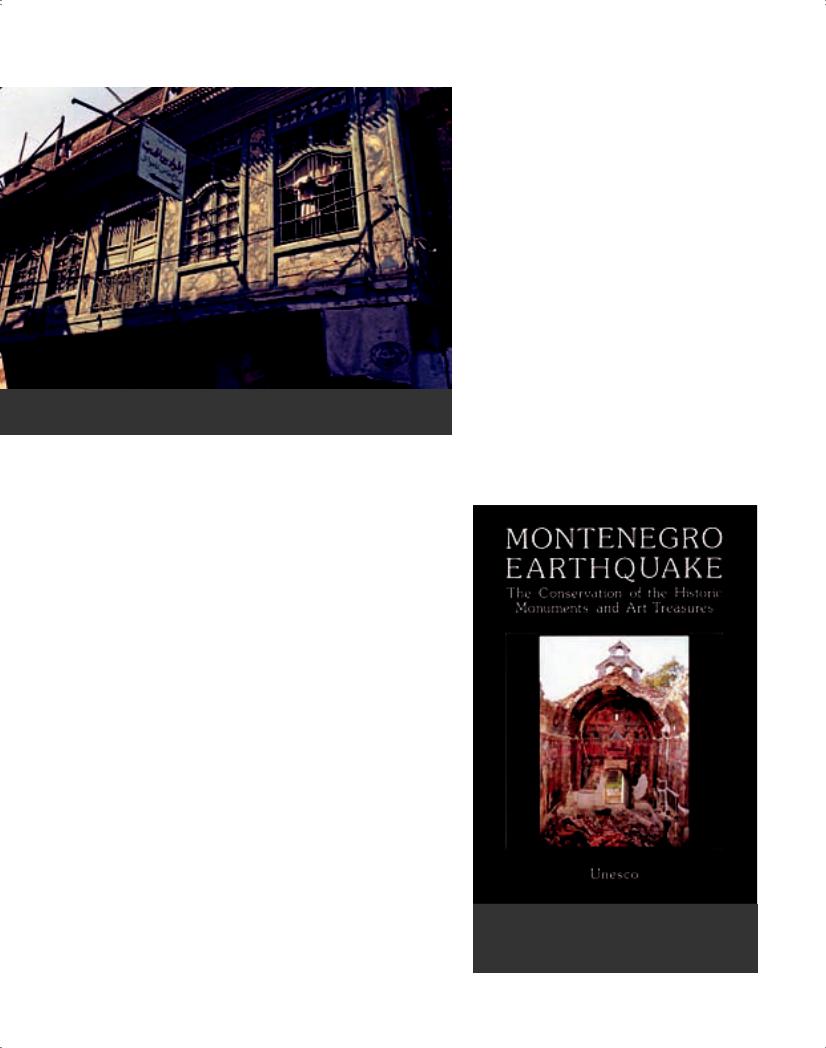
Figure 5 22
Traditional house in Baghdad
Feilden, and my attitude was exactly the same. You remember, Bernard Feilden travelled a lot. I think that UNESCO created ICCROM because it could do things that UNESCO would never have achieved, in terms of staff, in terms of programme orientation. I also felt that the governing bodies were much less politicized. It was easier to get decisions on mainly substantive ground. There was then a phase when certain members of the Council had a more political attitude, but I have the feeling that this passed. This did not continue. When I left UNESCO, I had a feeling it was already calming down.
ICCROM. Of course, the position of the Council of ICCROM is different from that of UNESCO, where it is more political. At ICCROM, each person should sit in the Council for professional reasons, even though through a political election.
Anne Raidl. Yes, and I think, for this reason, there was a certain friendship amongst the members of the Council, who came for several years, some really for many years. This was part of the whole positive effect of ICCROM. The members of the Council were also stimulating in their own country and beyond the borders of their country, in connection with ICCROM, in the dissemination of knowledge and of ideas.
During Feilden’s directorship, ICCROM took part in several technical missions in earthquake areas. One of these was a UNESCO seminar on earth-
quakes in Antigua Guatemala in 1979. There it was proposed to establish a centre for earthquake studies based on the programme of the Consejo Nacional para la Protección de la Antigua Guatemala, to undertake a research programme and then a course on earthquake protection proposed for 1981-1982.
In 1979 a powerful earthquake caused much destruction in historic towns in Montenegro, including Budva, Bar, Hercegnovi, Kotor and Ulcinj. ICCROM organized several expert missions to the region in 1979-1983 to advise on reconstruction and was a member of the UNESCO Advisory Board and UNESCO Working Group that discussed not only the repair of historic structures but also the development of appropriate urban and territorial planning in this region. Kotor received particular attention since in the same year it was inscribed on the World Heritage List of UNESCO as an emergency inscription.
ICCROM’s experience following the Friuli, Guatemala and other earthquakes resulted eventually in the publication of Bernard Feilden’s Between two Earthquakes: Cultural Property in Seismic Zones
(Getty Conservation Institute, Los Angeles, 1987). The World Heritage Convention, adopted by
UNESCO’s General Conference in 1972, became
Figure 5 23
UNESCO-ICCROM publication for fundraising to assist in the recovery process after the 1979 earthquake
76 |
ICCROM and the Conservation of Cultural Heritage. A history of the Organization’s first 50 years, 1959-2009 |
|
|
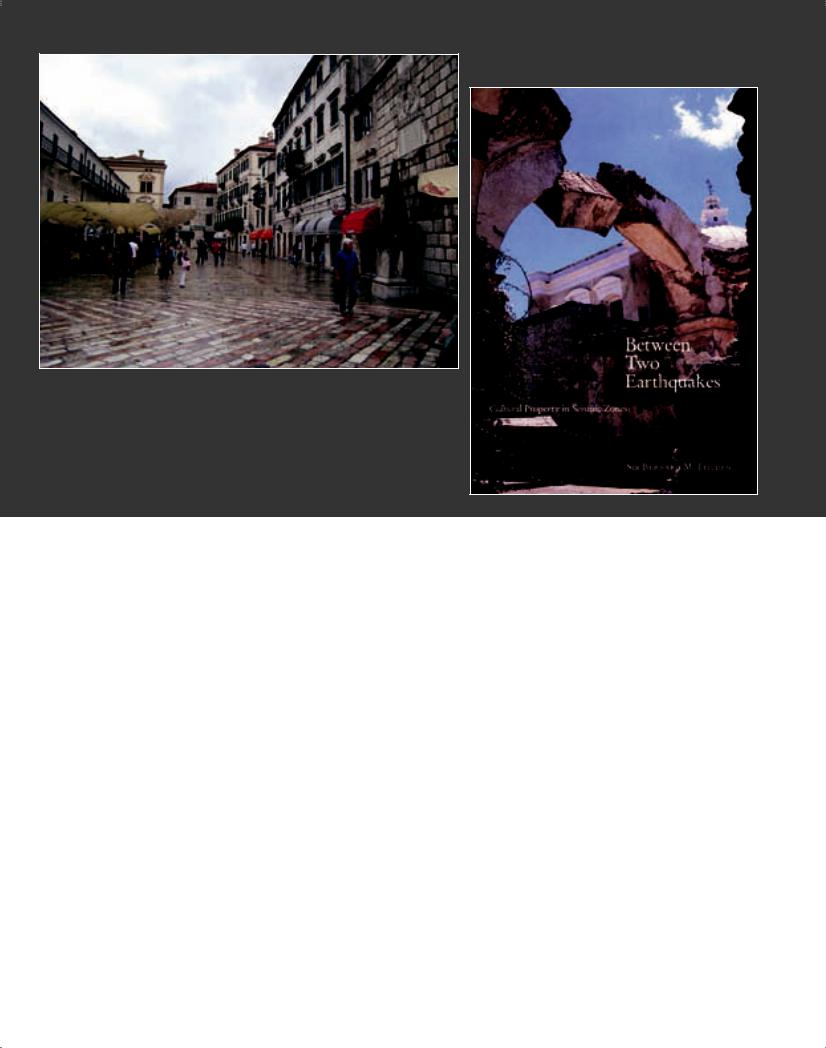
Figure 5 24
Kotor in Montenegro, which was badly damaged in the 1979 earthquake, after restoration (photo 2010)
Figure 5 25
Bernard Feilden’s Between Two Earthquakes, published by the Getty Conservation Institute jointly with ICCROM
effective in 1976, and the first General Assembly took place in Nairobi in November to elect the members of the World Heritage Committee. The first session of the Committee took place in Paris (27 June to 1 July 1977) where it elected by acclamation Firouz Bagherzadeh (Iran) as its Chairman, Peter H. Bennett (Canada) as rapporteur, and Egypt, France, Nigeria and Poland as Vice-Chairs. The establishment of the World Heritage Committee initiated a ‘running-in period’ for the implementation of the Convention which has since matured into a major factor in safeguarding the world’s cultural and natural heritage. The Convention designated ICCROM as one of the three Advisory Bodies to the Convention (together with ICOMOS and IUCN). It therefore took part in the development of the basic ideas on which the Convention was based. Paul Philippot, as Director of the Centre, had written a proposal for the definition of the Outstanding Universal Value, complemented by Ernest Allen Connally and Ann Webster Smith of ICOMOS who proposed the first draft of the inscription criteria.182 In the early years, limited resources meant that ICCROM was often represented by a former diplomat, Jacques-Louis Rollet-Andriane, with Torraca supervising ICCROM’s participation in the Convention.
The collaboration with ICOM and particularly its Conservation Committee continued, involving ICCROM in a number of projects related to the conservation of collections and preventive conservation in museums. ICCROM in the person of Gaël de Guichen co-ordinated the Committee’s Working Group on Climate and Lighting Control. With the financial support of the Direction of French Museums, ICCROM developed a travelling version of the permanent exhibition on Climate and Light in Museums already designed and installed at San Michele in Rome. The travelling exhibition was first shown in Zagreb during the ICOM Conservation Committee meeting, and was then taken to Bucarest, Timisoara, Budapest and further afield.183 ICCROM also contributed to training in this field, for instance at the request of the Brazilian Committee of ICOM, de Guichen in 1979 gave a one-week course in Rio de Janeiro to a group of 17 museum curators. When ICOM acted as consultant for the renovation of the Cairo Archaeological Museum, Luis Monreal, its Secretary-General, asked ICCROM to collaborate in the development of storage and exhibition facilities.
The collaboration with ICOMOS led to participation in a number of activities, such as the General Assemblies of ICOMOS in Moscow in 1978
5 ICCROM comes of age (1977-1988) |
77 |
|
|
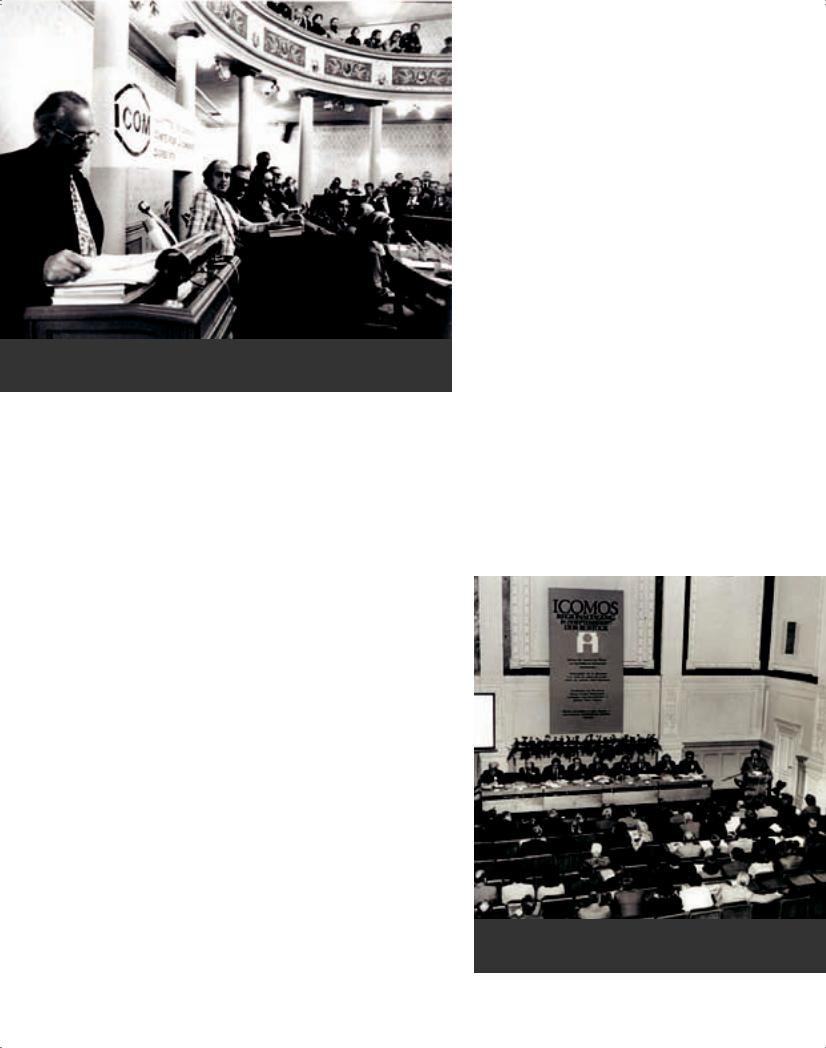
Figure 5 26
Bernard Feilden speaking to the ICOM-CC triennial meeting in Zagreb in 1978
and in Rome in 1981, and the ICOMOS meeting on Participation of Youth in the Care and Reactivation of Historic Towns held in Rostock, German Democratic Republic. ICCROM worked closely also with the International Scientific Committees of ICOMOS, particularly the Committee for the Conservation of Stone and its working groups such as the RILEM group for mechanical testing, and the biological, petrography and chemistry groups. This collaboration was of value in developing the UNESCO International Course on Stone Conservation in Venice. ICCROM was active in the ICOMOS Photogrammetry Committee (CIPA), represented by Sergio Lucarelli and in the Committee for the Conservation of Mud Brick (Adobe) Monuments, which held regional meetings in Santa Fe, USA (October 1977) and in Ankara, Turkey (September-October 1979). The Ankara meeting included a fieldtrip to the Göreme valley in Cappadocia where ICCROM was working on the conservation of Byzantine mural paintings in the rock-cut churches. The church that had been chosen for a pilot project was completed and re-opened to the public in 1980.
As for doctrine, in these years the Venice Charter was re-worked by the ICOMOS National Committee of Australia in the form of the Burra Charter, first issued in 1979.184 The aim was to interpret the concepts of the Venice Charter in terms adjusted to that particular region. Instead of speaking of monuments and sites, the Burra Charter adopted the notion of ‘place’, which it defined as: “site, area, land, landscape, building or other work, group of buildings or other works, and may include components, contents, spaces and views.” The
Charter also used the notion of ‘cultural significance’ and defined ‘conservation’ as “all the processes of looking after a place so as to retain its cultural significance” (Art. 1, 1999 version). This Charter has become widely influential, especially in many nonEuropean countries.
Reflection on the period 1977-1981
Bernard Feilden came from an architectural conservation practice and had a strong management background. He was also fully aware of the socioeconomic and cultural requirements of professionals in their careers. He consolidated ICCROM by giving it a name (and a flag), and providing it with a secure basis for sustainable organizational growth. His vision aimed at clarifying how to bring theory to practice, and how to sustain each other and to work in interdisciplinary teams for effective conservation. Feilden referred to the ideas of William Morris, and insisted on regular inspections and a maintenance strategy, taking into account the urgent, immediate, necessary and optional needs of the heritage resource. These ideas are integral to his later publications on the Conservation of Historic Buildings and the Management Guidelines for World Cultural Heritage Sites. During his term, ICCROM advised on a number of missions to assist Member States affected by natural disasters. He was well aware of human weaknesses and the tendency
Figure 5 27
Regional conference of ICOMOS in Rostock, GDR, 1977
78 |
ICCROM and the Conservation of Cultural Heritage. A history of the Organization’s first 50 years, 1959-2009 |
|
|
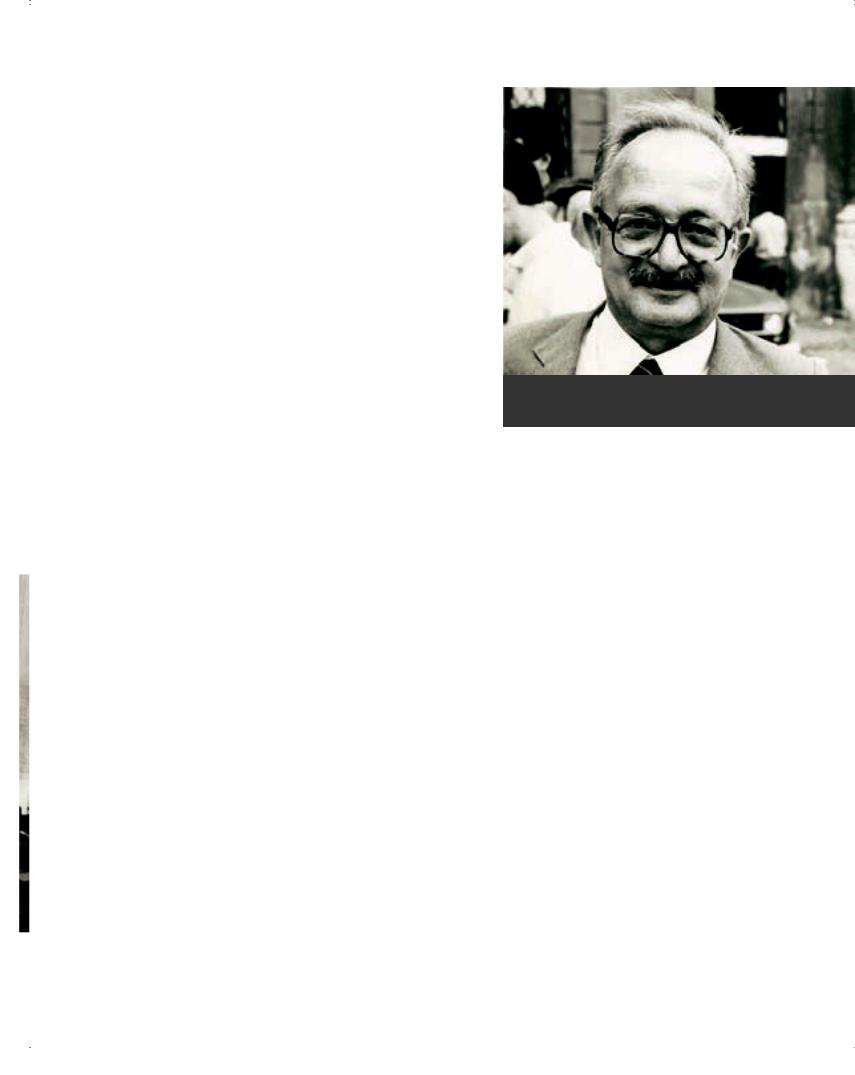
to forget. It was based on his practical experience in Guatemala, Mexico and the former Yugoslavia that he produced the manual Between Two Earthquakes. Under Feilden, ICCROM developed into a multidisciplinary team, which was able to react at short notice and effectively. In his introduction to the Council Report in 1981, the year in which he decided to retire, he wrote:
“The essence of conservation is in the diagnosis of causes of decay and the minimum action to prevent this decay and to correct damage caused by such decay. This is a scientific approach in an artistic-historical-archaeological-archival field, using manual skills. .... conservation is nobody’s baby. Yet, it must be recognized that as part of a humanistic awakening there is a conservation movement which will make a vital contribution to the post-industrial era, which is emerging.
Conservation of cultural property, including man-made landscape, is an important part of this world wide movement. It is a rapidly developing and expanding field, increasing conversely with a world tendency towards recession in consumption because conservation is contrary to wasting resources. So while most activities are contracting, wise governments will ensure that their conservative agencies are expanded. In this way they will save both cultural property as well as money and create valuable agencies and institutions for the future. ICCROM depends on a true understanding of the multidisciplinary role and benefits of conservation. ICCROM is meeting ever increasing demands for its services because it is a professionally orientated organization meeting real needs efficiently.”185
A network of people (1981-1988): the directorship of Cevat Erder
On 4 July 1981 Professor Dr. Cevat Erder took up office as newly appointed Director. Erder had obtained his Ph.D. in Classical Archaeology at the University of Ankara and was Professor for restoration of historic monuments at the Middle East Technical University (METU). There had he founded an M.Sc. specialization course in restoration of historic monuments and sites, one of the earliest training centres in conservation studies in the world. From the 1960s he was a visiting lecturer at Princeton University in the USA. He was the founding president
Figure 5 28
Cevat Erder, fourth Director of ICCROM (1981-1988)
of the Turkish National Committee of ICOMOS and member of the Executive Committee of International ICOMOS from 1972 to 1981, eventually being awarded the Piero Gazzola Prize by the 14th General Assembly of ICOMOS in 2003.
Erder had had a long association with ICCROM’s programmes, collaborating in various field projects such as those in Göreme Valley, Turkey, and since 1974 he had been a regular lecturer on the Architectural Conservation Course.
ICCROM – UNESCO collaboration
The World Heritage Committee had started its meetings in 1977 but ICCROM, as an Advisory Body, was not always regularly represented. Anne Raidl, at the time Director of the Cultural Heritage Division of UNESCO and co-responsible for administering the World Heritage Convention, insisted that it should. As a result Jokilehto became the regular representative of ICCROM, first attending the meetings in 1982.
Regarding collaboration between ICCROM and UNESCO, Anne Raidl recalled that she was as confident with Cevat Erder as she had been with Bernard Feilden:
“Yes, I have equally good memories of Cevat Erder. I found him very serious and very kind. I also had the impression that he knew very well what he wanted to do. The collaboration with him was just as good as with Feilden in terms of UNESCO-ICCROM relationship. One could count on ICCROM, one could count on its
5 ICCROM comes of age (1977-1988) |
79 |
|
|
